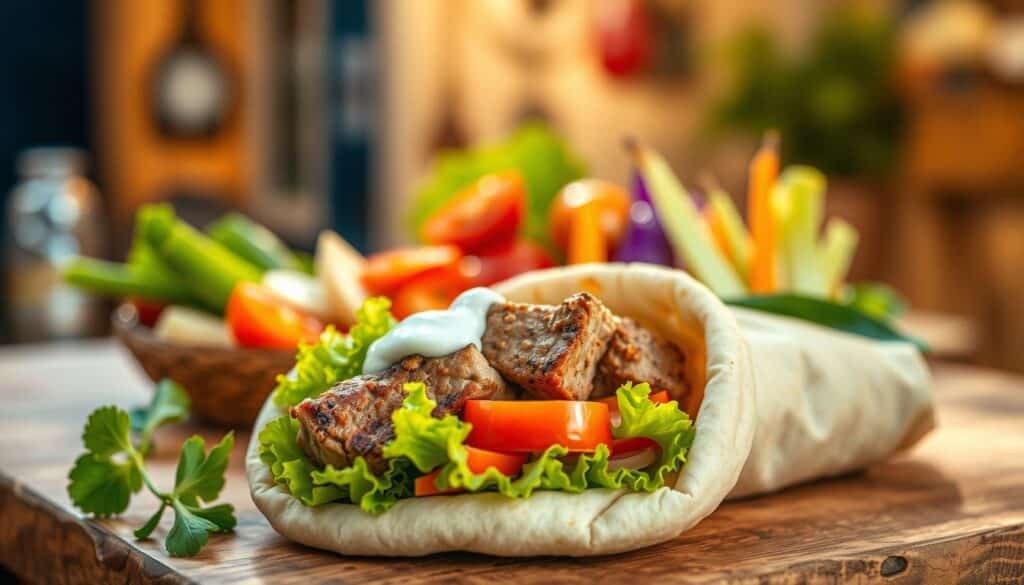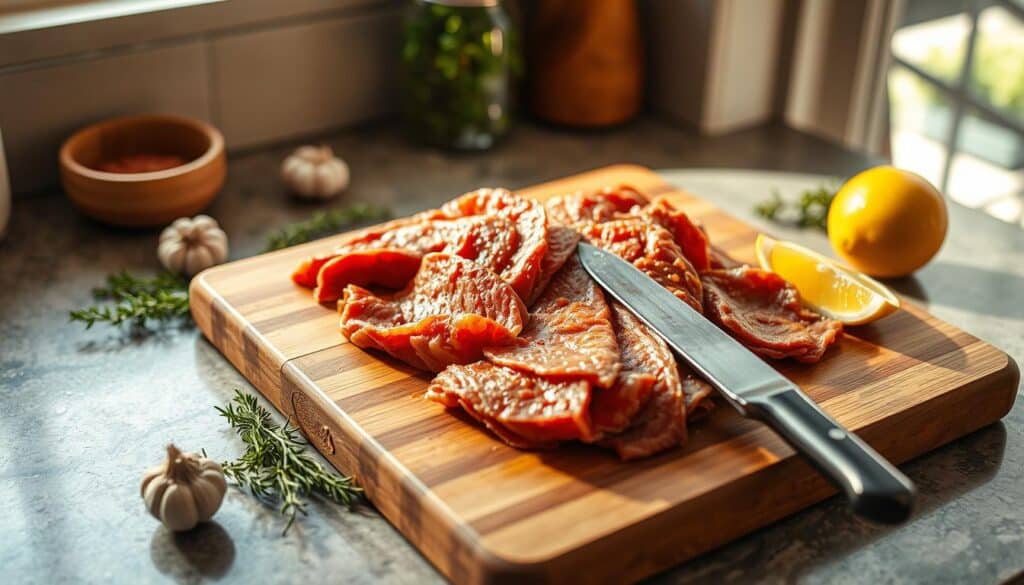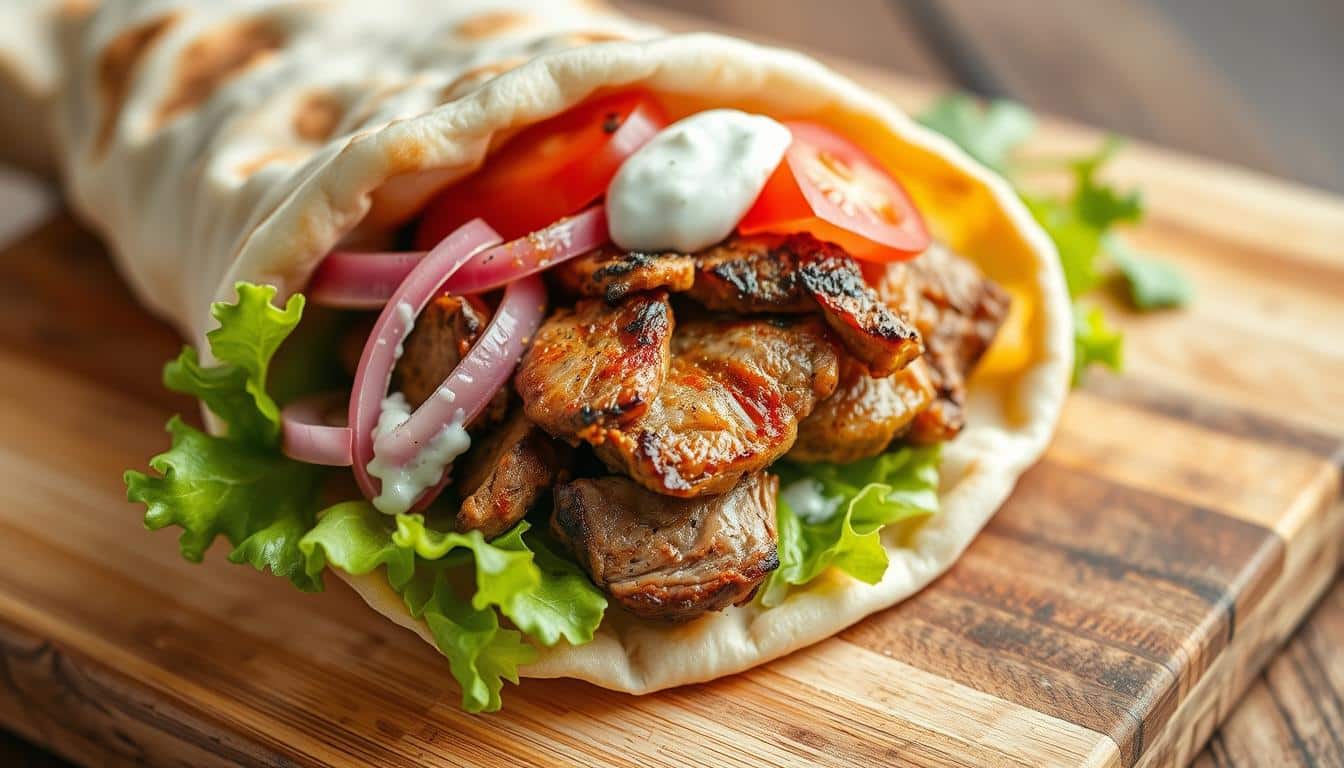There’s something magical about biting into a perfectly crafted gyro. The combination of tender, flavorful Greek gyro meat, crisp vegetables, and creamy tzatziki sauce wrapped in warm pita bread is a taste sensation like no other. For me, it’s more than just a meal—it’s a trip back to the bustling streets of Athens, where the aroma of slow-cooked lamb and the hum of lively chatter fill the air.
Thank you for reading this post, don't forget to subscribe!At the heart of this beloved dish is the vertical rotisserie, a traditional cooking method that ensures even distribution of heat and locks in the juiciness of the meat. The process is simple yet precise: layers of seasoned meat are stacked, and as they cook, thin slices are carved off and served. It’s a method that’s been perfected over generations, relying on quality ingredients like olive oil, garlic, and a sprinkle of oregano.

What makes a great gyro? It’s all about balance. The meat should be rich and aromatic, the pita bread soft yet sturdy, and the toppings fresh and vibrant. Whether you’re using lamb, beef, or pork, the key is to let the natural flavors shine through without overcomplicating the recipe. And let’s not forget the tzatziki sauce—made with Greek yogurt, cucumber, and a hint of garlic—it’s the perfect cooling contrast to the warm, savory meat.
If you’re anything like me, the idea of making gyros at home might seem intimidating. But trust me, it’s easier than you think. With a few simple ingredients and some patience, you can bring the authentic taste of Greece right into your kitchen. This guide will walk you through every step, from preparing the gyro meat to assembling the perfect pita. So, let’s get started on this delicious journey!
Key Takeaways
- Authentic gyros are made with slow-cooked meat on a vertical rotisserie for even cooking.
- The dish typically includes fresh vegetables like tomato, onion, and cucumber.
- Tzatziki sauce is a must-have for its cooling, creamy contrast to the savory meat.
- You can make gyros at home using ground lamb, beef, or pork.
- The traditional recipe requires minimal ingredients but attention to detail for the best flavor.
- Gyros are a versatile meal that can be customized with your favorite toppings.
For a detailed recipe and more tips, check out this Authentic Greek Gyros Recipe to make your next meal unforgettable.
Introduction to Authentic Greek Gyros
My first encounter with a genuine gyro was nothing short of magical. It was during a trip to Athens, where the vibrant streets were filled with the enticing aroma of seasoned lamb. That moment sparked a deep curiosity, leading me on a journey to uncover the authentic flavors of Greek cuisine.
My Journey to Discovering True Greek Flavors
As I delved deeper, I discovered the simplicity and richness of traditional gyro preparation. The use of fresh ingredients like tomatoes, red onions, and a dollop of tzatziki sauce added layers of flavor that I hadn’t experienced before. What truly fascinated me was the role of spices—marjoram, oregano, and a hint of garlic—that brought the dish to life.
Speaking with local chefs, I learned about the importance of olive oil and the careful balance of salt and pepper. These elements, though simple, are crucial in enhancing the natural flavors of the ingredients without overpowering them.
An Overview of Traditional Gyro Culture
Gyro culture is more than just a meal; it’s a tradition passed down through generations. The rotisserie method of grilling meat ensures even cooking and retains the juiciness, making each bite tender and flavorful. The traditional toppings—fresh tomatoes, crisp red onions, and creamy tzatziki sauce—add a refreshing contrast to the warm, savory meat.
For those interested in the history of gyros, this resource provides a detailed look. If you’re looking for a meatless option, this baked ziti recipe offers a delicious alternative.

In the following sections, we’ll explore the process of creating authentic gyros at home, from selecting quality ingredients to mastering the cooking techniques. Whether you’re a seasoned cook or a curious beginner, this guide will help you bring a taste of Greece into your kitchen.
Exploring Greek Gyros Grilled meat cooked on a spit served in pita bread with vegetables
What makes a gyro truly authentic? It’s all about the balance of flavors and textures that come together to create a dish that’s both satisfying and delicious. Let’s dive into the key characteristics that define a genuine gyro.
Key Characteristics of a Genuine Gyro
A genuine gyro is more than just a meal; it’s an experience. The heart of this dish lies in its preparation and ingredients. The vertical rotisserie is essential, as it ensures even cooking and locks in the juiciness of the meat. Thinly sliced layers of lamb, beef, or pork are stacked and cooked to perfection, creating a crispy exterior while retaining tenderness inside.
The blend of spices is another critical factor. A mix of salt, pepper, oregano, and a hint of garlic enhances the natural flavors without overpowering them. This traditional seasoning is what sets an authentic gyro apart from its fast-food counterparts.
| Feature | Authentic Gyro | Fast Food Version |
|---|---|---|
| Ingredients | High-quality meats (lamb, beef, pork), fresh vegetables, and tzatziki sauce | Processed meat mixtures, limited toppings |
| Cooking Method | Vertical rotisserie for even cooking and fat drainage | Mass-produced, often pre-cooked and reheated |
| Texture | Crispy exterior, juicy interior | Often dry or overcooked |
| Taste | Rich, aromatic, with a balance of spices | Less complex, may lack freshness |
While store-bought gyros are convenient, crafting them at home allows for greater control over quality and customization. The process might seem daunting, but with the right ingredients and a bit of patience, you can achieve that authentic flavor in your own kitchen.
In the next section, we’ll guide you through the process of creating the perfect gyro recipe at home, from selecting the finest ingredients to mastering the cooking techniques.
Creating the Perfect Gyro Recipe at Home
Bringing the authentic flavors of Greece into your kitchen is easier than you might think. With a few simple steps and quality ingredients, you can craft a delicious gyro that rivals your favorite restaurant.
Choosing Quality Ingredients and Preparing the Meat
Selecting the right ingredients is the foundation of a great gyro. I always opt for freshly ground lamb or a mix of lamb and beef for the most authentic flavor. Marinating the meat is essential—mix in olive oil, garlic, oregano, and a pinch of salt and pepper. Let it rest in the fridge for at least two hours to allow the flavors to meld together.

Step-by-Step Cooking Techniques and Timing
Preheat your oven to 325°F (165°C). Place the marinated meat in a baking dish, cover it with foil, and bake for 45 minutes. Remove the foil and continue baking for another 20-25 minutes, or until the edges are lightly browned. Let the meat rest for 10-15 minutes before slicing it thinly. This resting period is crucial for retaining moisture and flavor.
- Ensure the pan is hot before adding the meat to achieve a nice sear.
- After cooking, tilt the pan to drain excess fat for a crisper texture.
While the meat cooks, warm your pita bread in the oven for a few minutes. Prepare your toppings—thinly sliced onion, a dollop of tzatziki sauce, and a sprinkle of salt and pepper. Assemble everything just before serving for the freshest taste.
Tips for Authentic Flavor and Presentation
Achieving the perfect balance of flavors in a gyro is an art form, and I’m excited to share my personal secrets to make it just right. It all starts with the marinade, where olive oil, garlic, and oregano take center stage. I always let the meat marinate for at least two hours to soak up all those delicious flavors.
Mastering Traditional Seasonings and Marinades
The key to a great marinade is using high-quality ingredients. I recommend using fresh garlic and oregano for the best flavor. Let the meat sit for at least two hours, or even overnight if possible, to really let those flavors meld together.
Artful Assembly with Tzatziki, Tomatoes, and Onions
When it comes to assembling your gyro, it’s all about the layers. Start with a dollop of tzatziki sauce on the pita, then add slices of juicy meat. Top it off with thinly sliced tomatoes and onions for a fresh crunch. Don’t forget to wrap it neatly for a clean, satisfying bite!
What sets an authentic gyro apart is the attention to detail. While some might skip the fresh veggies or skimp on the sauce, those little touches make all the difference. Trust me, the extra effort is worth it for that authentic taste.
Conclusion
As I reflect on my journey to master the art of creating authentic gyros at home, I’m reminded of the simple yet profound connection between tradition and taste. The process, while detailed, is incredibly rewarding. By focusing on quality ingredients like lamb, careful marination, and traditional cooking methods, you can craft a dish that truly honors its origins.
Every element, from the tender meat to the fresh toppings, plays a vital role in creating a memorable meal. I encourage you to experiment in your kitchen, sharing your experiences and the joy of this culinary tradition. Remember, authenticity isn’t just about the recipe—it’s about the love and care you put into every step.
If you’ve tried this recipe or have your own gyro story, I’d love to hear about it. Let’s continue the conversation and celebrate the beauty of homemade gyros together!
FAQ
What is the best way to cook gyro meat at home?
The best way to cook gyro meat at home is to use a rotisserie or a pan. If you don’t have a rotisserie, you can slice the meat thinly and cook it in a pan with a little oil over medium heat. This method ensures even cooking and a crispy texture.
How long does it take to prepare a homemade gyro meal?
Preparing a homemade gyro meal typically takes about 1 hour, including preparation and cooking time. This includes slicing the meat, preparing the tzatziki sauce, and assembling the pita with tomatoes and onions.
What are the essential ingredients for a traditional gyro?
The essential ingredients include lamb or beef, salt, pepper, oregano, garlic, onion, tomato, and tzatziki sauce. You can also add olive oil for cooking and bread for serving.
Can I make gyro meat without a rotisserie?
Yes, you can make gyro meat without a rotisserie. Simply shape the ground meat into a loaf, season it with salt, pepper, and oregano, and cook it in the oven at 375°F (190°C) for about 45 minutes. Let it rest before slicing.
How do I make tzatziki sauce?
To make tzatziki sauce, combine yogurt, grated cucumber, garlic, salt, and a drizzle of olive oil. Let it chill in the fridge for at least 30 minutes before serving to allow the flavors to meld.
Can I use beef or pork instead of lamb?
Absolutely! While lamb is traditional, you can use beef or pork as alternatives. For a more authentic taste, mix beef with a little pork fat to keep the meat juicy.
How do I ensure the gyro meat stays juicy?
To keep the gyro meat juicy, don’t overcook it. Use a meat thermometer to check the internal temperature, and let the meat rest for a few minutes before slicing. Adding a small amount of fat to the meat mixture also helps retain moisture.
Can I prepare the gyro ingredients ahead of time?
Yes, you can prepare the meat mixture and tzatziki sauce a day in advance. Store them in separate containers in the fridge until you’re ready to cook and assemble the gyros.
What is the best type of oil to use for cooking gyro meat?
Olive oil is the best choice for cooking gyro meat, as it adds a rich, savory flavor. However, you can also use other neutral oils like vegetable oil if preferred.
How do I achieve the right seasoning for the gyro meat?
The key seasonings are salt, pepper, garlic, and oregano. Mix these into the ground meat thoroughly before cooking for a balanced and authentic flavor.
Can I serve gyro as a side dish?
While gyro is typically a main meal, you can serve smaller portions as a side dish. Pair it with a simple green salad or roasted vegetables for a well-rounded meal.
There are no reviews yet. Be the first one to write one.

